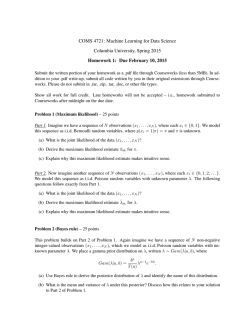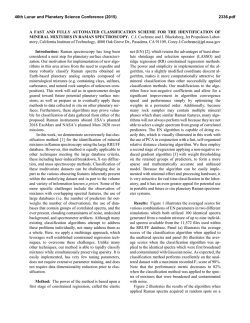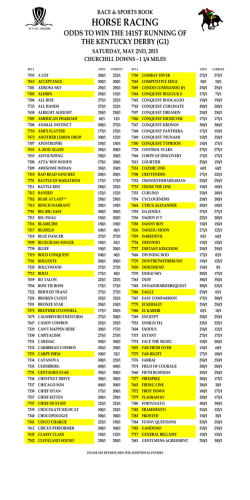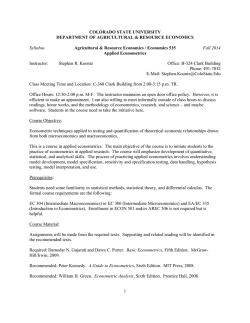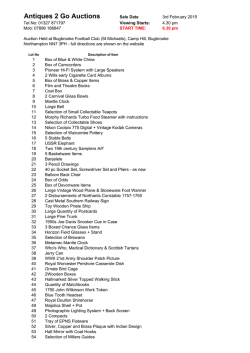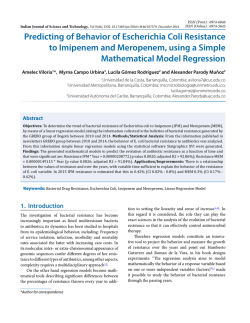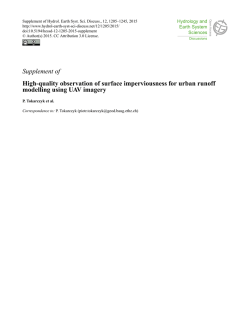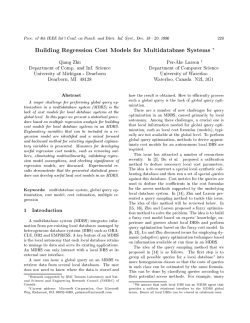
• When and why do we use logistic regression - Virgil Zeigler-Hill
1/29/2015 PSY 512: Advanced Statistics for Psychological and Behavioral Research 2 • When and why do we use logistic regression? – Binary – Multinomial • Theory behind logistic regression – Assessing the model – Assessing predictors – Things that can go wrong • Interpreting logistic regression To predict an outcome variable that is categorical from predictor variables that are continuous and/or categorical Used because having a categorical outcome variable violates the assumption of linearity in normal regression The only “real” limitation for logistic regression is that the outcome variable must be discrete Logistic regression deals with this problem by using a logarithmic transformation on the outcome variable which allow us to model a nonlinear association in a linear way It expresses the linear regression equation in logarithmic terms (called the logit) 1 1/29/2015 Can the categories be correctly predicted given a set of predictors? What is the relative importance of each predictor? Are there interactions among predictors? How good is the model at classifying cases for which the outcome is known? Absence of multicollinearity No outliers Independence of errors – assumes a between subjects design • There are other forms of logistic regression if the design is within subjects Ratio of cases to variables – using discrete variables requires that there are enough responses in every given category • If there are too many cells with no responses, then the model will not fit the data Odds-like probability: Odds are usually written as “5 to 1 odds” which is equivalent to 1 out of five or .20 probability or 20% chance, etc. The problem with probabilities is that they are non-linear Going from .10 to .20 doubles the probability, but going from .80 to .90 barely increases the probability Odds ratio: The ratio of the odds over 1 minus the odds The probability of winning over the probability of losing 5 to 1 odds equates to an odds ratio of .20/.80 = .25. Logit: This is the natural log of an odds ratio; often called a log odds even though it really is a log odds ratio The logit scale is linear and functions much like a z-score scale Logits are continuous, like z scores p = 0.50, then logit = 0 p = 0.70, then logit = 0.84 p = 0.30, then logit = -0.84 2 1/29/2015 An ogive function is a curved s-shaped function and the most common is the logistic function which looks like: ೠ ܻᇱ݅ ൌ ଵା ೠ Where Y’ is the estimated probability that the ith case is in a category and U is the regular linear regression equation: U = A + B1X1 + B2X2 +…+BKXK Probability of coronary heart disease For a response variable y with p(y=1)= P and p(y=0) = 1- P Logistic regression will allow for the estimation of an equation that fits a curve the age/probability of CHD relationship A regression method to deal with the case when the dependent variable y is binary (dichotomous) x 3 1/29/2015 Change in probability is not constant (linear) with constant changes in X This means that the probability of a success (Y = 1) given the predictor variable (X) is a non-linear function, specifically a logistic function It is not obvious how the regression coefficients for X are related to changes in the dependent variable (Y) when the model is written this way Change in Y(in probability units)|X depends on value of X Look at S-shaped function • • The values in the regression equation A and B1 take on slightly different meanings. • • A B1 The regression constant (moves curve left and right) The regression slope (steepness of curve) Constant regression constant different slopes • v2: A = -4.00 B1 = 0.05 • v3: A = -4.00 B1 = 0.15 • v4: A = -4.00 B1 = 0.025 Constant slopes with different regression constants • v2: A = -3.00 B1 = 0.05 • v3: A = -4.00 B1 = 0.05 • v4: A = -5.00 B1 = 0.05 4 1/29/2015 The logistic regression equation can be written in terms of an odds ratio for success Odds ratios range from 0 to positive infinity Odds ratio: P/Q is an odds ratio; less than 1 = less than .50 probability, greater than 1 means greater than .50 probability P = probability of success; Q = probability of failure • Log-odds are a linear function of the predictors The regression coefficients go back to their old interpretation (kind of) • • The expected value of the logit (log-odds) when X = 0 Called a ‘logit difference’; The amount the logit (log-odds) changes, with a one unit change in X; the amount the logit changes in going from X to X + 1 Outcome • We predict the probability of the outcome occurring A and B1 • Can be thought of in much the same way as multiple regression • Note the normal regression equation forms part of the logistic regression equation This is the probability of Y occurring Outcome • We predict the probability of the outcome occurring A and B1 • Can be thought of in much the same way as multiple regression • Note the normal regression equation forms part of the logistic regression equation This is the base of natural logarithms. It is a constant that is approximately equal to 2.718281828. The natural logarithm of a number X is the power to which e would have to be raised to equal X. It is very helpful for estimating the area under a curve 5 1/29/2015 Outcome • We predict the probability of the outcome occurring A and B1 • Can be thought of in much the same way as multiple regression • Note the normal regression equation forms part of the logistic regression equation This is the simple linear regression model. Yintercept moves the curve left or right. The slope influences the steepness of the curve Outcome • We still predict the probability of the outcome occurring Differences • Note the multiple regression equation forms part of the logistic regression equation • This part of the equation expands to accommodate additional predictors • The Log-likelihood statistic – Analogous to the residual sum of squares in multiple regression – It is an indicator of how much unexplained information there is after the model has been fitted – Large values indicate poorly fitting statistical models 6 1/29/2015 Indicates the change in odds resulting from a unit change in the predictor. • Odds Ratio > 1: Predictor ↑, Probability of outcome occurring ↑ • Odds Ratio < 1: Predictor ↑, Probability of outcome occurring ↓ Simultaneous: All variables entered at the same time Hierarchical: Variables entered in blocks • Blocks should be based on past research, or theory being tested (Best Method) Stepwise: Variables entered on the basis of statistical criteria (i.e., relative contribution to predicting outcome) • Should be used only for exploratory analysis Predictors of a treatment intervention Participants • 113 adults with a medical problem Outcome: • Cured (1) or not cured (0) Predictor: • Intervention: intervention (1) or no treatment (0) SPSS Syntax: compute a=intervention. LOGISTIC REGRESSION VAR=cured /METHOD=ENTER a /CRITERIA PIN(.05) POUT(.10) ITERATE(20) CUT(.5). 7 1/29/2015 This tells us how SPSS has coded our outcome variable. If we used O and 1, then it will be the same as we used. If we used something else (e.g., 1 and 2), then SPSS will convert it to 0 and 1 This tells us how SPSS has coded our categorical predictor variable. If we used O and 1, then it will be the same as we used This assesses model fit with larger values corresponding to poorer fitting models. The Log Likelihood is multiplied by -2 because this gives it an approximate chi-square distribution 8 1/29/2015 The initial model involves the outcome variable without any predictors in the model so SPSS defaults to predicting the most likely outcome. 65 were “cured” and 48 were “not cured” so it will choose “cured” as the default . This represents the Y-intercept without any predictors in the model This table presents the information for the variables that were not included in the Step 0 model 9 1/29/2015 This model includes “intervention” as a predictor variable. The -2 Log Likelihood assess model fit (lower values indicate better fit). The chi-square test compares the fit of this model with the Step 0 model This table identifies the accuracy of the predictive model when “intervention” was included as a predictor variable This is a pseudo-R2 which allows us to estimate how much of the variability in the outcome variable can be explained by the model 10 1/29/2015 This value is the unstandardized regression coefficient that represents the slope of the model. It represents the change in the logit of the outcome variable (natural logarithm of the odds of Y occurring) associated with a one-unit change in the predictor variable The Wald statistic is the crucial value because it tells us whether the B coefficient is significantly different from 0. If it is significantly different from 0, then we can assume that the predictor is making a significant contribution to the prediction of the outcome variable This is the odds-ratio which is the odds (success) over 1 minus the odds (failure). In this example, we can say that the odds of a patient who is treated being cured are 3.41 times higher than those of a patient who is not treated 11 1/29/2015 • The overall fit of the final model is shown by the -2 log-likelihood statistic – If the significance of the chi-square statistic is less than .05, then the model provides a significant fit for the data • • Check the table labelled Variables in the equation to see which variables significantly predict the outcome Use the Wald statistic or the odds ratio, Exp(B), for interpretation – Odds Ratio > 1, then as the predictor increases, the odds of the outcome occurring increase – Odds Ratio < 1, then as the predictor increases, the odds of the outcome occurring decrease • • • Logistic regression to predict membership of more than two categories It (basically) works in the same way as binary logistic regression The analysis breaks the outcome variable down into a series of comparisons between two categories. – Example: if you have three outcome categories (A, B, and C), then the analysis will consist of two comparisons that you choose: • Compare everything against your first category (e.g. A vs. B and A vs. C), • Or your last category (e.g. A vs. C and B vs. C), • Or a custom category (e.g. B vs. A and B vs. C). • The important parts of the analysis and output are much the same as we have just seen for binary logistic regression 12
© Copyright 2026
